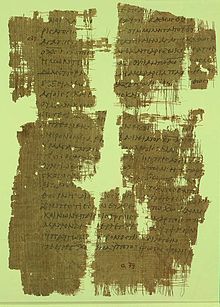
Back Efesiërs Afrikaans الرسالة إلى أهل أفسس Arabic ܐܓܪܬܐ ܕܠܘܬ ܐܦܣܝܐ ARC الرساله الى اهل افسس ARZ Briaf an de Ephesa BAR Buku Epesus BBC Ліст да Эфесянаў Святога Апостала Паўла Byelorussian Пасланьне да эфэсянаў BE-X-OLD Послание на свети апостол Павла до ефесяни Bulgarian Lizher d'an Efezidi Breton
| Part of a series of articles on |
| Paul in the Bible |
|---|
 |
| Part of a series on |
| Books of the New Testament |
|---|
 |

The Epistle to the Ephesians[a] is the tenth book of the New Testament. According to its text, the letter was written by Paul the Apostle, an attribution that Christians traditionally accepted. However, starting in 1792, some scholars have claimed the letter is actually Deutero-Pauline, meaning that it is pseudepigrapha written in Paul's name by a later author strongly influenced by Paul's thought. According to one scholarly source, the letter was probably written "by a loyal disciple to sum up Paul's teaching and to apply it to a new situation fifteen to twenty-five years after the Apostle's death".[3][4][5][6][7][8][9]
- ^ ESV Pew Bible. Wheaton, IL: Crossway. 2018. p. 976. ISBN 978-1-4335-6343-0. Archived from the original on 3 June 2021.
- ^ "Bible Book Abbreviations". Logos Bible Software. Archived from the original on 21 April 2022. Retrieved 21 April 2022.
- ^ Authenticity of Ephesians, Bible apologetics.
- ^ Hoehner, Harold. Ephesians: An Exegetical Commentary. Baker Academic, 2002. ISBN 978-0-8010-2614-0
- ^ Ehrman, Bart D. (2004). The New Testament: A Historical Introduction to the Early Christian Writings. New York: Oxford. pp. 381–84. ISBN 0-19-515462-2.
- ^ "Introduction", NAB – Ephesians, USCCB, archived from the original on 4 January 2009, retrieved 17 January 2009
- ^ Cite error: The named reference
barthwas invoked but never defined (see the help page). - ^ Perrin, Norman; Duling, Dennis C. (1982). The New Testament: An Introduction (2nd ed.). New York: Harcourt Brace Jovanovich. pp. 218–22. ISBN 0-15-565726-7.
- ^ Brown, Raymond E. The churches the apostles left behind, Paulist Press, 1984. ISBN 978-0-80912611-8.
Cite error: There are <ref group=lower-alpha> tags or {{efn}} templates on this page, but the references will not show without a {{reflist|group=lower-alpha}} template or {{notelist}} template (see the help page).